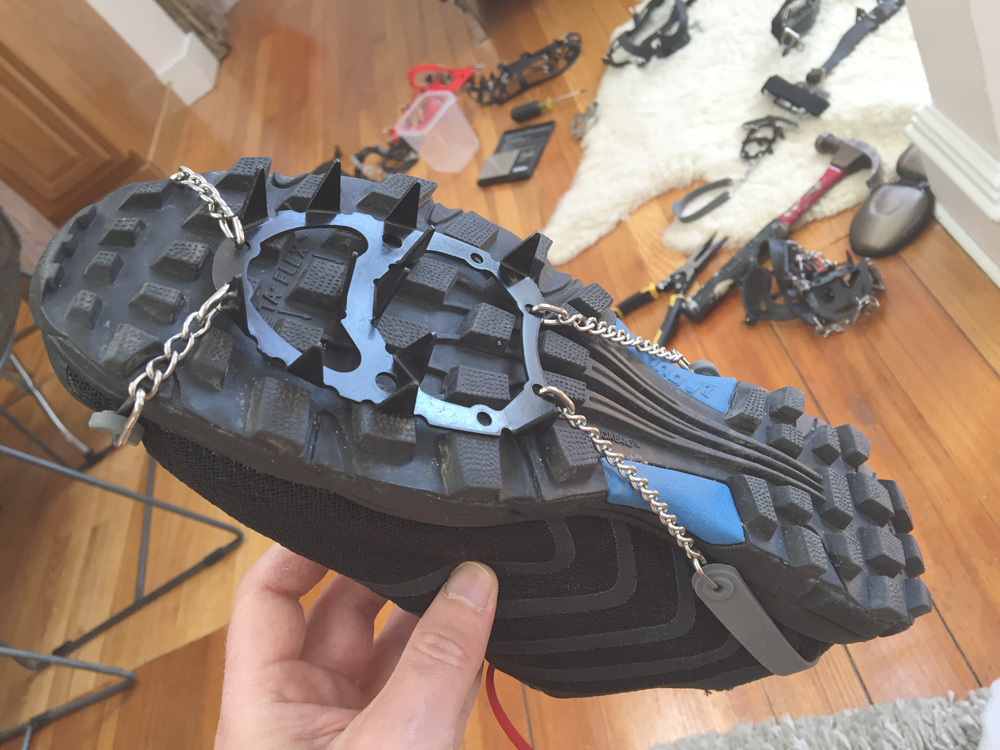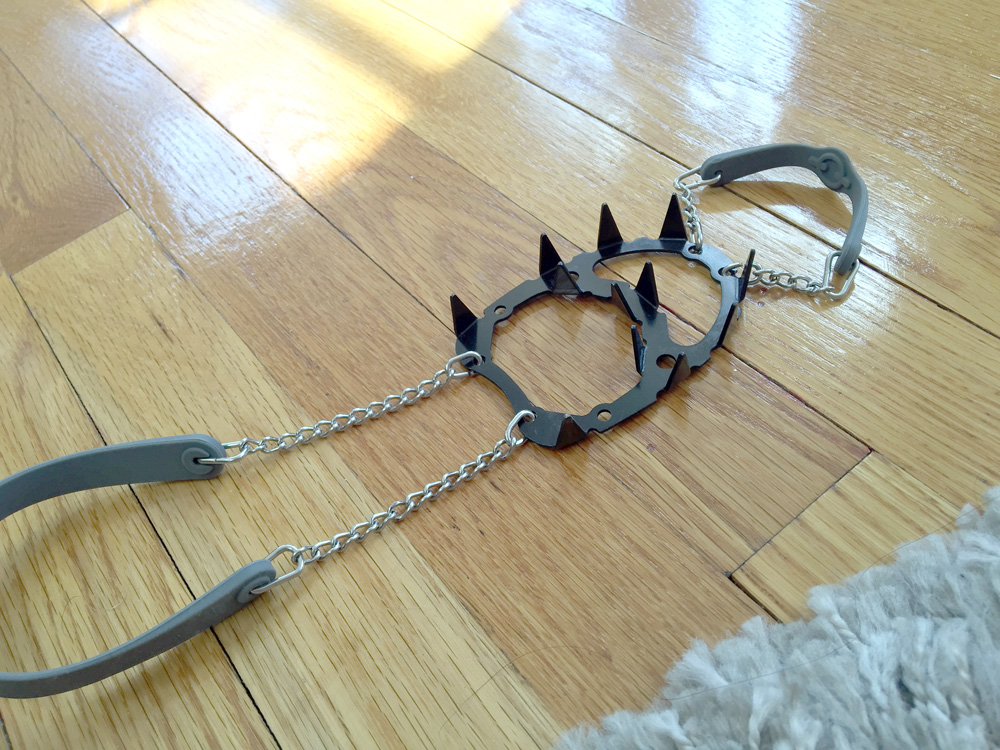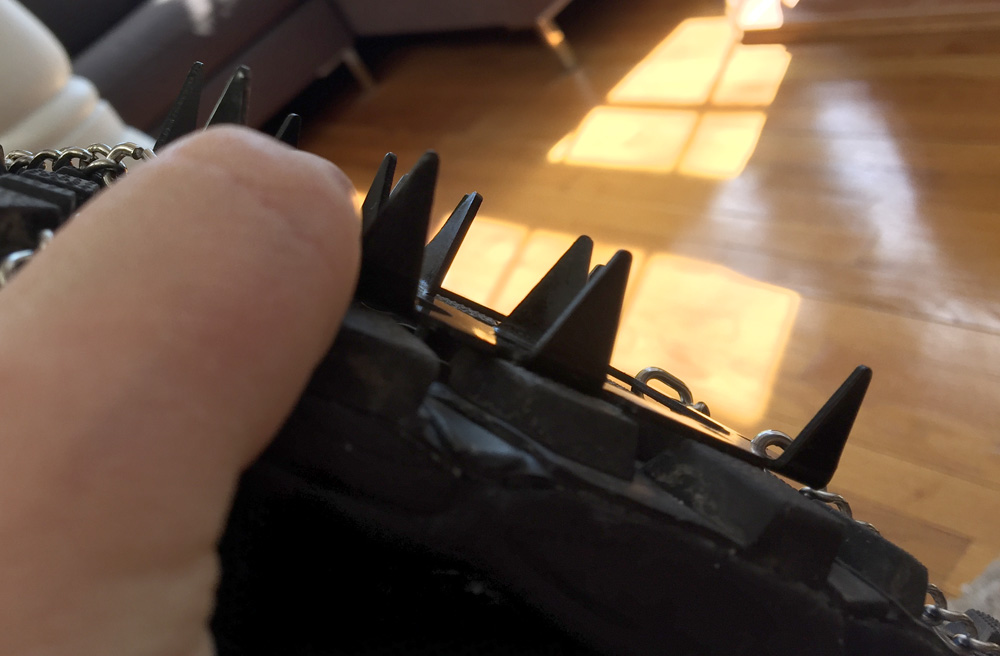Topic
Are these the lightest crampons ever made?
Forum Posting
A Membership is required to post in the forums. Login or become a member to post in the member forums!
Home › Forums › Gear Forums › Gear (General) › Are these the lightest crampons ever made?
- This topic has 24 replies, 15 voices, and was last updated 8 years ago by
 rmeurant.
rmeurant.
-
AuthorPosts
-
Mar 19, 2016 at 11:36 am #3390371
Weight: 4.9 size L per pair
Teeth: 12 per crampon
Material: Steel
Wearing method: rubber & chains, similar to Microspikes. full chain on bottom of shoe
Put on/Take off time: 5 seconds
Packed size: 3 x 0.5″, no sharp point sticking out
Front grip: no movement
Side grip: no movementOver the past few years I’ve been toying with the idea to frankenstein the lightest, strongest, the most compact and most user-friendly hiking crampons for serious mountain terrain. A paradox, it seems. I’m happy to report that, finally, after a lot of research, tinkering in the lab, and countless orders of mainstream crampons, I have a prototype made for SUL hikers.
Originally, the inspiration came after trying on Microspikes. Microspikes are super-quick to put on and take off and generally a great crampon for winter hiking. However, here in White Mountains, the slope is more vertical, there’s more ice and the terrain is quite a bit more serious. In this place Microspikes simply do not work. The teeth are short and the grip slips.
I think this new prototype is going to work much better in serious mountains. Like the Microspikes, these are not made for ice climbing or technical mountaineering. Pics below. Been posting early bits on other forum strings, so thought I’d start a new chain since the crampons are ready.
Would love to hear your comments on these. Psyched to try them out next weekend on Mount Washington.



 Mar 19, 2016 at 12:11 pm #3390373
Mar 19, 2016 at 12:11 pm #3390373Right after you turn off Tuckerman trail and start on the Lion Head winter trail, I personally could not climb that chute without front points.
But with your locale listed as NH and Whites I assume you’re familiar with the chute and can negotiate it without front points and are comfortable not having heel spikes.
Very nice hack, nevertheless!
Mar 19, 2016 at 12:25 pm #3390374Thanks Bob, Lion’s Head winter route chute is exactly what I’m hoping to try with these on. I do it w/o front points, but really need lots of long, strong teeth and good heel stability. With good teeth and ice axe in hand it’s doable. I’ll post how the crampons worked once we get up there, hopefully next week, before the snow melts.
Mar 19, 2016 at 3:40 pm #3390406Fascinating!
I have experimented with titanium, but we don’t have a lot of testing opportunities here in Oz.Cheers
Mar 19, 2016 at 4:30 pm #3390415There are a pair of microspike like clones out there that use a ceramic piece in the locations where the metal meets the rubber compound.
I have broken through a pair of microspikes due to the rubber eventually ripping.
I just see that you went all out on your design so having these grommets may be a huge help.
Mar 19, 2016 at 4:57 pm #3390419Not that I know what I am talking about here (no direct experience…) but that front rubber strap looks a bit too forward for the downhill bits (?)
Mar 19, 2016 at 4:58 pm #3390420@Roger I’d love to take these spikes to titanium. Will shave off an ounce or more without any compromise on durability. That could make a 3.5oz, heavy duty 12pt crampon! That would be sick! A friend of mine has a shop with titanium, so if these work in the field, I will definitely go to titanium next. Will be updating this post as the design gets evolved.
@Aaron – true that on Microspikes rubber. Once tested, my plan is to significantly thicken the rubber areas around the grommets. Shouldn’t really add weight, but will certainly make the last a while. The problem I see in other Microspikes-like crampons is that the rubber portions stretch slightly onto the bottom of the shoe. That’s where the wear will kill the rubber fast. On the design I got going, the only thing ever touching the bottom is the chain. Should make for good durability.
@Franco – not sure if the front rubber is too far forward, will have to test it out. The reason front rubber is so short is because it really keeps the forward and side motion almost at zero. Any suggestions?Mar 19, 2016 at 5:40 pm #3390435Mar 19, 2016 at 6:26 pm #3390444RE: “Heavier by a couple ounces, but at a hard to beat price:”
Instep “crampons” are not real crampons in the sense of mountaineering. With no spikes under the front of your foot or the rear they are awkward at best… must walk kinda flat footed to assure the spikes are engaged. Normal walking (heal contact first, then roll to front of foot) would be treacherous when on heel or ball of foot. (much worse than microspikes) And that’s just the problem for trail walking… Actual climbing forget it… they do not secure well to the foot and certainly can’t front point or even up on the ball of your foot.
As for Gary’s design… if you are really going to do steep stuff you should be using boots and normal crampons… if the rubber mount doesn’t twist off your foot, I fear your trail runner will.
As for looking at your design… for one… the points are rounded… they need to be sharp for real ice… as for the points being longer than microspikes… on real hard ice that will not help as hardly 1/8 of an inch will penetrate real hard ice… but softer ice or harder snow… yes… as for trails with mixed rock, mud, ice, snow… I’d rather have the microspikes as I think they would be less awkward on rocks and mixed rocks/mud/ice trails…. but longer spikes are good if you know you are going to be on only snow and ice… but if it’s ice I would want a real crampon and real boots… not trail runners… as for calling them 12 point crampons… that is deceptive as traditionally a 10 point crampon has spikes at the heel and ball of foot but just not front points… normally the term 12 point crampon means that plus 2 front points for front point technique… In short… seems like a lot of mixing of apples and oranges terminology… not saying Gary’s invention won’t be just perfect for some situations… but certainly not all… and if you know what you are doing Gary that is fine… but I always get concerned about these kinds of things being touted here on BPL for fear that the inexperienced will take these things out and try to do stuff that will get them seriously injured or even killed…
Billy
Mar 19, 2016 at 6:35 pm #3390449Any suggestions?
Sorry no as I don’t have any experience with crampons.
What I did, the same as I do when folk post about DIY projects that somehow interest me, I put those crampons on (in my mind…) walked and climbed up and down and that strap twisted off.
So my observation was only from playing with them in my head.Mar 19, 2016 at 7:05 pm #3390455I agree with Billy 100%. In terrain where one needs the traction of crampons, sacrificing safety for weight and/or ease of donning seems unwise.
I carry the Grivels – yes they weigh a pound, but I know I’m secure on varied, icy terrain.
http://www.outdoorgearlab.com/Crampon-Reviews/Grivel-Air-Tech-Light
Mar 19, 2016 at 7:09 pm #3390457For myself, I’d feel better using some mid-type boots and something like these below, which are advertised to weigh 680g/pair. Found HERE on Amazon for $79 (shipped, if you have Prime). I nearly bought some Kahtoola K10s at the AMC store at Pinkham Notch but couldn’t get past the lack of front points.
 Mar 19, 2016 at 7:13 pm #3390458
Mar 19, 2016 at 7:13 pm #3390458Totally agree with being wise on safety. However, I do have the same Grivel Air tech that I’ve been using to hike the same sections along with SUL spikes. So far I use the SUL spikes a lot more. They are much safer on self-arrests, take a few seconds to don on and off and they do not move on the foot at all. All at 20% of the weight.
Being a 4-season SUL hiker, I go into places where you really need good traction. With more testing, I think you’ll be able to use these spikes over a much wider terrain than MicroSpikes and the like. For very steep uphill climbing – absolutely stick with Grivels. However, you may be quite surprised at the results of the upcoming testing in the tough terrain.
Mar 19, 2016 at 7:16 pm #3390460For trail walking front points would be in the way… not good.
And if it’s mixed rock/ice/mud I would prefer the small chain/spikes of microspikes over the longer spikes of crampons (especially instep crampons). Longer spikes will not conform to rocks/dirt/ice/mud as well and could cause stumbling or tripping. Trails are generally not steep so crampons are not necessarily required… but steep & Icy off-trail climbing… crampons indeed!billy
Mar 19, 2016 at 7:44 pm #3390465Personally, on a mostly snow/ice hike/climb I’d “bring a bigger boat” (-Capt Brody, “Jaws”), but for High Sierra travel where getting over a single pass or a nasty spot of north-sloping trail can weigh on your mind for the whole trip, these are a great solution.
I like the very low weight. I like the compactness. I like the ease of stored them, pointy-bits-inwards, with a simple rubber band. I like that the chain portion adds a little more traction, in addition to the spikes themselves. I like the numerous angles of the points – since at some time, every different angle from your shoe is downslope.
Suggestions: The points seem a bit a long. A big paddle in the snow is good in, well, snow. But on ice, smaller spikes work just as well and aren’t so hard to walk on (especially over rock and you ALWAYS traverse some rock on any ice/snow trip). Instead of the rubber/chain straps, how about 3/4″ flat webbing and a ladder-lock (metal not Fastex) buckle? Stronger, quickly adjustable, if you go into production, it is truly one-size-fits-all. MUCH more easily field-repairable (2 feet of flat webbing, a 21-gram SAK Classic and 6 overhand knots per crampon and you’re on your way again).
I learn a lot when I destroy things. What is the tensile strength of that set up, end-to-end? I’m guessing it will fail at the rubber/chain junction at 30-40 pounds. Or, depending on what chain is used, those chain links might fail at 20 pounds. Versus 3/4″ flat webbing which would be good for 200 pounds or more. And maybe lighter weight. I’d use a steel 3/4″ buckle for testing and try to source an aluminum version if you go into production.
Mar 19, 2016 at 7:54 pm #3390466There are pluses and minuses to most things…
I would think webbing would have less friction than the rubber and this tend to shift if not roll off the foot more easily. Also, webbing, like ropes, would tend to get wet and freeze stiff…But worth a try…
Mar 19, 2016 at 8:40 pm #3390480More observations re Gary’s ‘crampons’:
If used on hard ice where the points don’t sink in then the front part of the foot is elevated but the heel of the foot is lower. That would be awkward. And worse on mixed terrain where rocks would make for an uneven and maybe unstable surface…. But If the points sink in to softer snow that would be better.
Also, I note that the points are inset from the edge of the boot/shoe… not good on hard ice where edging might be needed.
Billy
Mar 21, 2016 at 4:44 am #3390744You never edge crampons on ice. This is different for front points, but the ‘ordinary 10 points’ are always flat on the ice.
Mar 21, 2016 at 8:43 am #3390768“You never edge crampons on ice. …but the ‘ordinary 10 points’ are always flat on the ice.”
Never say never…
That’s the ideal… but the real is sometimes different.
There are many times where uneven surfaces do not allow for ‘flat’ technique… ice and snow does not always come in flat surfaces… and then there are rocks :)billy
Mar 21, 2016 at 10:03 pm #3390976Really brilliant, Gary. Love the design. Much better than the Ti ones you posted about last year.
While I wouldn’t call them crampons, they are much lighter than carrying Microspikes for slick spots.
Please let us know when they become available.
Thanks.
Mar 21, 2016 at 10:26 pm #3390980Gary, I look forward to the field report. Those could be very handy in the right conditions. If the spikes were shortened, adding a few short flanges to provide a better edge for snow might meet the mixed demands of ice & snow traction. That would get the sole closer to the ground and might improve comfort when rocks come into play.
“While I wouldn’t call them crampons, they are much lighter than carrying Microspikes for slick spots.” – Sam, I agree. Maybe “ball spikes” would be a better descriptor?
Mar 21, 2016 at 10:59 pm #3390984i suspect that going down hill may be an issue with the lack of heel spikes …
also theres almost no lateral support for the points so i suspect that it might be harder to side hill or use the french technique …
the way its designed i suspect that the fit may actually be pretty shoe (or shoe type) specific … for example if you have a set of 5.10 guide tennies give em a try and see if its secure …
i suspect you may need more/better attachment points …
;)
Mar 23, 2016 at 11:21 am #3391330I would put these in the category of the Vargo’s Pocket Cleats. Both very light, effective traction devices (similar to Microspikes, but much lighter). I wouldn’t call them crampons, but that is just semantics. Compared to the Pocket Cleats, yours are just a bit heavier. But I can see the advantage of either. The Pocket Cleats are meant to work on trail runners, and only trail runners. They won’t work on bigger boots (or so I’ve read). Yours look a lot more flexible.
As far as improvements, I wonder how much each piece weighs. Vargo uses titanium, straps and buckles (no chain or rubber). Obviously the titanium saves weight, but I wonder if using straps and lightweight buckles saves weight as well. The chain will never break, but other than that, I’m not sure of the advantage of it. The rubber is probably strong, but can crack over time (although I think it is rare for people to have problems with Micro Spikes). I have no idea if there are better alternatives for either. There may be a lightweight, very durable cord material out there I don’t know about.
In general it looks like a great design. I could easily see how people would transition from Micro Spikes to this. When you get into weights like this, you often get into “might as well bring it” territory, which ultimately means you are providing a safer thing. Real crampons are nice, but not when they are sitting at home because you figured you wouldn’t need them.
Feb 11, 2017 at 6:44 pm #3450186So how did these work out? Just found this thread and I like the design a lot. Seems like what I want out of my microspikes most often, too… would be curious if you ended up doing a follow up or anything?
Feb 12, 2017 at 8:57 pm #3450313I would agree with other posters that these should not be called “crampons”, and I don’t believe they function properly as crampons. They are a different category of product. They certainly have their uses, and spikes of this general kind are very popular in Korea (termed “Eisen” e.g., http://item2.gmarket.co.kr/English/detailview/item.aspx?goodscode=167895813 i.e., metal spikes with rubber straps), but I don’t believe that they should be considered for anything serious (Gary does state “these are not made for ice climbing or technical mountaineering”). (There are also various more serious intermediate products here that combine the spikes with steel cables, but are less than proper crampons). In addition, the rubber type can tend to distort the boot, if it is not of strong construction. Also, they can tend to disengage from the boot – I finished one hike with a very light pair to find that I’d actually lost one en route, and had never even noticed the difference… or was that the soju?
-
AuthorPosts
- You must be logged in to reply to this topic.
Forum Posting
A Membership is required to post in the forums. Login or become a member to post in the member forums!
HAPPENING RIGHT NOW (February 11-21, 2025) - Shop Hyperlite Mountain Gear's Biggest Sale of the Year:
Our Community Posts are Moderated
Backpacking Light community posts are moderated and here to foster helpful and positive discussions about lightweight backpacking. Please be mindful of our values and boundaries and review our Community Guidelines prior to posting.
Get the Newsletter
Gear Research & Discovery Tools
- Browse our curated Gear Shop
- See the latest Gear Deals and Sales
- Our Recommendations
- Search for Gear on Sale with the Gear Finder
- Used Gear Swap
- Member Gear Reviews and BPL Gear Review Articles
- Browse by Gear Type or Brand.








